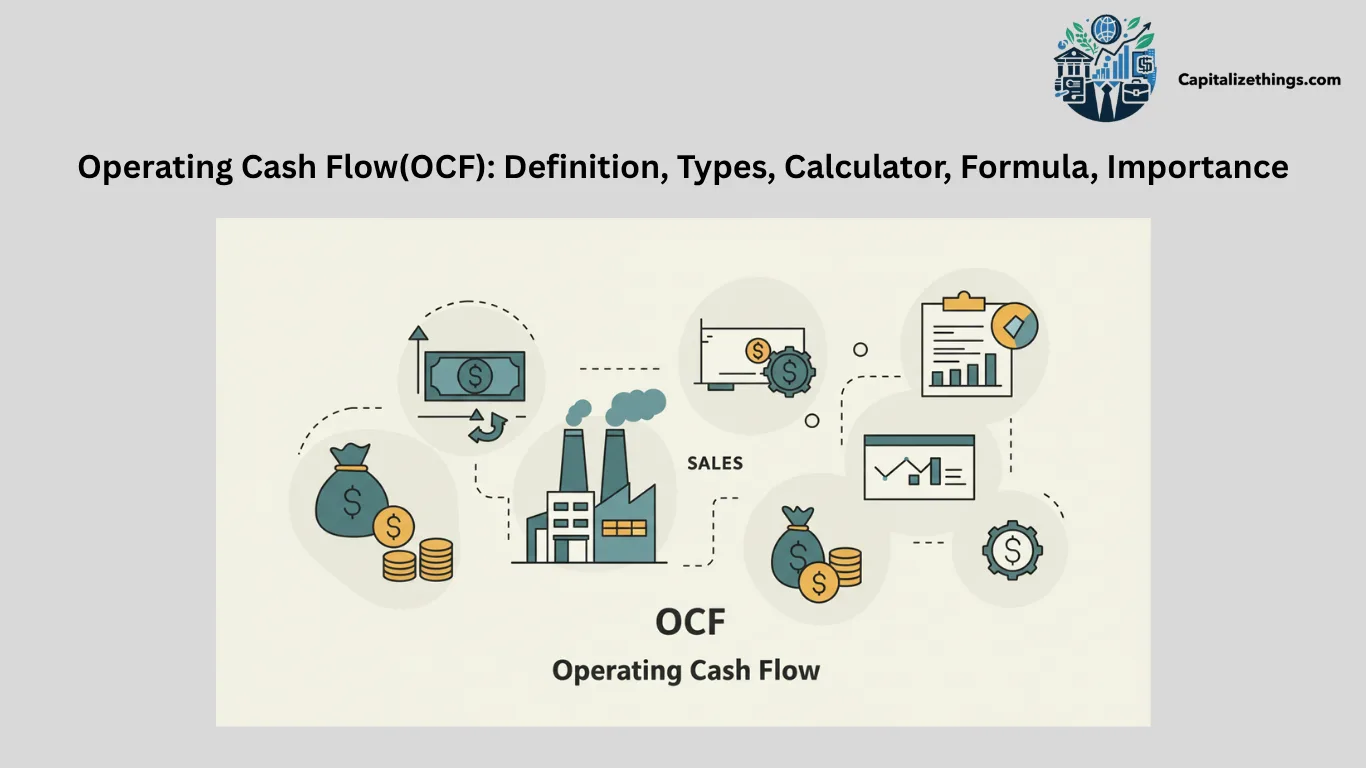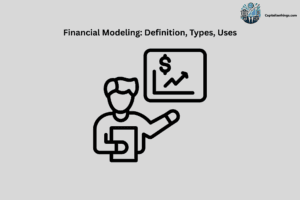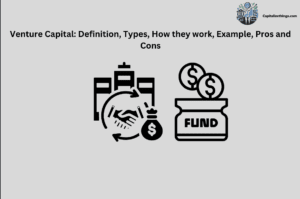Operating Cash Flow (OCF) is the cash a company generates from its core business operations, showing how much money it makes before considering investments or financing activities. It helps determine if a company can sustain itself and fund its daily activities without relying on outside capital. OCF is calculated by adjusting net income for non-cash expenses like depreciation and changes in working capital, such as inventory and accounts receivable. According to the Corporate Finance Institute (2022), this metric is vital for assessing a firm’s operational health and liquidity.
There are three primary methods to calculate OCF: direct, indirect, and hybrid. The direct method tracks actual cash inflows and outflows, while the indirect method adjusts net income for non-cash items and working capital changes. Most companies use the indirect method due to its compatibility with accrual accounting standards. Investors and analysts rely on OCF to evaluate a firm’s financial stability and ability to generate sustainable cash flows. A strong OCF ratio—typically above 1.0—indicates that a company can cover its short-term liabilities, which is essential for long-term viability and investor confidence.
What Is Operating Cash Flow (OCF)?
Operating Cash Flow (OCF) is the net cash generated or consumed by a company’s core operations, reflecting its ability to manage liquidity and fund ongoing activities. It excludes non-cash expenses and investments, focusing solely on cash inflows/outflows from primary business functions. The formula is: OCF = Net Income + Non-Cash Expenses ± Changes in Working Capital. For instance, a grocery chain with $80,000 net income, $10,000 depreciation, and a $5,000 reduction in inventory would calculate OCF as $95,000, demonstrating cash efficiency from core sales and inventory management.
According to the Corporate Finance Institute (2022), OCF is critical for assessing solvency and operational sustainability, as it isolates cash performance from accounting distortions. Investors use OCF to evaluate whether a business can fund growth, repay debts, or distribute dividends without external financing. A negative OCF ($X) might signal overreliance on borrowing or declining sales, whereas a positive OCF ($Y) aligns with robust operational health.
What Is A Good Operating Cash Flow Ratio For Investment?
A good operating cash flow ratio for investment is greater than 1.0, indicating a company can cover short-term liabilities with its operating cash flow. This ratio is calculated as Operating Cash Flow (OCF) divided by Current Liabilities (OCF/CL). According to Investopedia (2023), a ratio above 1.0 ensures liquidity, while ratios below 1.0 signal potential cash shortages.
A ratio of 1.5 or higher is optimal for attracting investors, as it demonstrates robust cash management. For example, TechCorp, a SaaS provider, maintained an OCF/CL ratio of 1.8 in 2023, enabling debt-free expansion and shareholder returns. Conversely, a restaurant chain with $120,000 net income but only $80,000 OCF faced delays in payroll and inventory due to a ratio of 0.8, per a 2022 Financial Times case study .
High ratios reflect disciplined working capital management and reduced reliance on external financing. Investors prioritize firms with consistent OCF/CL ratios above 1.5 to mitigate liquidity risks. For tailored OCF ratio analysis and investment strategy alignment, contact capitalizethings.com Financial Performance Advisory Services.
What If OCF Ratio Is Less Than 1?
An OCF ratio below 1 indicates insufficient operational liquidity to cover current debt obligations. This occurs when operating cash flow (OCF) is less than total current liabilities, calculated as OCF divided by current liabilities. For example, a retail company with $90,000 OCF and $120,000 in current liabilities has a ratio of 0.75, signaling cash shortfalls (according to Corporate Finance Institute, 2022 ). Such a ratio warns of liquidity stress and potential defaults on payments.
Companies with ratios under 1 face heightened risks, including delayed vendor payments and reduced creditor trust, which can escalate into supply chain disruptions and impaired growth opportunities. Additionally, this weakness may deter investors and increase borrowing costs due to perceived financial instability. To mitigate these risks, businesses must prioritize cash flow optimization through expense management or working capital adjustments.
Is OCF Ratio Useful For Startups?
No, the Operating Cash Flow (OCF) ratio is not typically useful for startups during their early stages of growth. Startups often prioritize scaling operations over generating positive cash flow, resulting in negative OCF due to high upfront investments. For example, a biotech startup may spend $2M on R&D and marketing while reporting zero revenue for 18 months, yielding an OCF ratio of -0.4. According to Harvard Business School’s Entrepreneurial Finance Report (2021), such metrics misrepresent startup viability during expansion phases.
The OCF ratio focuses on liquidity stability, which is irrelevant for startups in high-growth phases. Instead, founders use metrics like burn rate (cash spent monthly) or runway (time until cash depletion) to assess survival. A tech startup with a burn rate of $150,000/month and $3M in funding has a 20-month runway—far more actionable than an OCF ratio of -2.1.
However, the OCF ratio becomes critical once a startup achieves operational stability. For instance, a SaaS startup with recurring revenue and controlled costs (e.g., $500K monthly inflow vs. $300K expenses) can track OCF ratios to measure cash flow sustainability. This signals to investors that the business model is scalable and financially viable.
What Are The Different Types Of Operating cash Flow?
Operating Cash Flow (OCF) has 3 types: direct, indirect, and hybrid methods. The direct method tracks actual cash inflows from sales and outflows for expenses like inventory or salaries. It lists cash received from customers and payments to suppliers, offering granular visibility. For instance, Walmart uses this method to monitor real-time cash flows in its high-volume retail operations (Example). According to the International Financial Reporting Standards (IFRS) Foundation (2020), the direct method is ideal for firms with frequent transactions.
The indirect method adjusts net income for non-cash items (e.g., depreciation) and working capital changes (e.g., accounts receivable). It starts with net profit, adds back depreciation, and adjusts for inventory or accounts payable shifts. A 2023 study by McKinsey & Company found that 70% of global corporations use this method due to its alignment with accrual accounting standards.
The hybrid method combines direct and indirect approaches. It details cash received directly while using accrual adjustments for outflows. This method suits complex businesses like multinational conglomerates, such as Siemens, which balances transparency in revenue tracking with streamlined expense adjustments.
How To Calculate OCF For Investment Analysis?
Operating Cash Flow (OCF) quantifies the cash generated from a company’s core operations by adjusting net income for non-cash expenses and working capital changes. The formula OCF = Net Income + Non-Cash Expenses + Changes in Working Capital systematically isolates cash-generating capacity from accounting abstractions. For instance, a manufacturing firm reporting $100,000 net income, $20,000 depreciation, and a $10,000 increase in inventory would calculate OCF as $110,000, demonstrating its ability to convert profit into usable cash (Corporate Finance Institute, 2022).
Non-cash expenses like depreciation and amortization are added back to net income because they reduce taxable income without consuming cash (Damodaran, 2020). This adjustment ensures OCF reflects true cash flow rather than accrual accounting estimates. For example, a factory with $20,000 annual depreciation retains this amount as usable cash, which is critical for sustaining operations or reinvestment.
Changes in working capital components such as inventory and accounts payable directly impact OCF. A $10,000 inventory increase reduces cash availability, while a $15,000 accounts payable rise boosts cash reserves. Investors use these adjustments to evaluate a firm’s liquidity and operational efficiency. Strong OCF signals sustainable growth potential and reduces reliance on external financing.
How To Use OCF Calculator For Investment?
To use an OCF calculator for investment decisions, input financial data into the formula: OCF = Net Income + Non-Cash Expenses + Changes in Working Capital. This process quantifies a company’s operational cash generation, enabling investors to assess liquidity and profitability. For example, a tech firm with $2M net income, $500K depreciation, and a $300K decrease in working capital would calculate OCF as $2.8M, highlighting cash-generating efficiency. According to Corporate Finance Institute (2022), accurate OCF analysis requires precise inputs from financial statements.
First, input net income from the income statement. Add non-cash expenses like depreciation or amortization (e.g., $500K annual depreciation for machinery). Next, adjust for working capital changes: subtract increases (e.g., rising inventory) or add decreases (e.g., reduced accounts receivable). A calculator automates these steps, converting raw data into a clear OCF value. For instance, a retail company with stable inventory levels and declining payables could show improved OCF by $1.2M yearly, signaling better cash flow management.
Investors should verify data accuracy and compare OCF trends across periods. Clean financial records ensure reliable results; inconsistent data may skew interpretations. Regular OCF analysis helps identify firms with sustainable cash flows, critical for long-term investment viability. Use this metric alongside other ratios like free cash flow to prioritize investments in financially robust entities. Use the advanced OCF calculator below for your ease.
Operating Cash Flow (OCF) Calculator
Does OCF Include Depreciation In Its Formula?
Yes, operating cash flow (OCF) explicitly includes depreciation as a non-cash expense added back in its formula. Depreciation lowers net income but does not consume cash, so it is reversed in OCF calculations to reflect true cash generation. The standard formula OCF = Net Income + Non-Cash Expenses (e.g., Depreciation) ± Changes in Working Capital ensures depreciation is accounted for.
Depreciation represents the systematic allocation of an asset’s cost over its useful life. For example, a manufacturing firm with $2M net income and $500K annual depreciation would report $2.5M OCF before working capital adjustments, as depreciation is added back. According to The Fundamentals of Financial Management (Brigham & Ehrhardt, 2021), this adjustment is critical for assessing operational cash sustainability without external financing.
In industries like energy or transportation, where heavy assets dominate, depreciation significantly impacts OCF. A utility company with $10M net income and $2M annual depreciation would show a $12M OCF base, emphasizing cash generation despite asset wear-and-tear. Analysts must include depreciation to avoid underestimating liquidity in capital-intensive sectors.
How To Calculate OCF From Revenue And Receivables?
To calculate operating cash flow (OCF) from revenue and receivables, subtract the increase in accounts receivable (or add the decrease) from revenue. This adjusts revenue to reflect actual cash collected from customers. For instance, if revenue is $500,000 and receivables rise by $30,000, cash inflow from sales drops to $470,000 ($500K – $30K).
This method isolates cash received from sales, excluding credit extended to customers. A retail company with $1.2M in revenue and a $50K reduction in receivables would report $1.25M cash inflow from sales, highlighting improved collections. As noted in Corporate Finance Institute’s OCF Guide (2023), this approach aligns OCF with real cash movements rather than accrual accounting.
However, this simplified method ignores other OCF components like depreciation and working capital changes. A tech firm with $5M revenue, $1M receivables increase, and $200K depreciation would require adjustments: $5M – $1M + $200K = $4.2M OCF. Integrating receivables with full OCF formulas ensures comprehensive financial health analysis.
How To Analyze OCF From Cash Flow Statements?
To analyze OCF from cash flow statements, locate the OCF section at the top of the statement, which directly measures cash generated or consumed by core operations. Begin by examining the indirect method format, starting with net income, then adding non-cash expenses (e.g., depreciation) and adjusting for changes in working capital components like accounts receivable, inventory, and accounts payable. For example, a company with $10M net income, $2M depreciation, and a $1M decrease in inventory would calculate OCF as $13M ($10M + $2M + $1M).
Next, evaluate non-cash items and working capital shifts. Large non-cash adjustments (e.g., depreciation) inflate OCF but do not reflect cash availability. Conversely, rising inventory or receivables (e.g., a $5M inventory increase) reduces OCF, signaling cash tied up in operations. According to The Corporate Finance Institute (2022), consistent declines in OCF despite rising net income may indicate poor liquidity management.
Finally, compare OCF trends year-over-year. A firm with stable or growing OCF relative to revenue demonstrates strong operational efficiency. For instance, a company increasing OCF by 8% annually while revenue grows 5% shows improved cash conversion. Sudden OCF drops warrant further analysis of expense management or working capital policies.
What Is The Operating Cash Flow Formula With Direct Method?
Operating Cash Flow (OCF) using the direct method is calculated as:
OCF = Cash Received from Customers − (Cash Paid to Suppliers + Cash Paid for Wages + Cash Paid for Rent + Cash Paid for Taxes)
This formula directly measures cash inflows and outflows from core operations, ensuring transparency in tracking liquidity.
For example, a fruit shop with $100,000 in cash sales, $30,000 paid to suppliers, $20,000 in wages, $5,000 in rent, and $10,000 in taxes calculates OCF as:
OCF = $100,000 − ($30,000 + $20,000 + $5,000 + $10,000) = $35,000 (Corporate Finance Institute, 2022). This result quantifies the shop’s net cash generated from daily operations, excluding non-cash items like depreciation.
The direct method is ideal for small businesses (e.g., retail, hospitality) with granular cash transaction records. However, it requires meticulous tracking of each cash flow component. For instance, a bakery using this method must reconcile every cash receipt and payment to ensure accuracy. According to the American Institute of CPAs (AICPA), businesses with under $10M revenue often prefer the direct method for its operational clarity.
What Is The Operating Cash Flow Formula With Indirect Method?
The operating cash flow (OCF) formula using the indirect method begins by adjusting net income for non-cash expenses and changes in working capital to derive cash generated from core operations. The formula is:
OCF = Net Income + Non-Cash Expenses (Depreciation & Amortization) ± Changes in Working Capital (Inventory, Receivables, Payables) .
This method converts accrual-based net income into cash flow by incorporating adjustments for non-cash items (e.g., depreciation) and shifts in operating assets/liabilities. For example, a hypothetical tech firm with a net income of $150,000 USD adds depreciation ($25,000) and adjusts for inventory (+$10,000), receivables (-$5,000), and payables (+$10,000). Calculation:
OCF = $150,000 + $25,000 − $10,000 + $5,000 + $10,000 = $180,000.
This result demonstrates the firm’s ability to generate cash beyond reported profits. According to Brigham & Ehrhardt (2020), the indirect method is critical for large enterprises using accrual accounting, as it reconciles profit with actual cash performance.
The formula’s structure ensures transparency in financial reporting. Non-cash items like depreciation are added back (since they reduce net income without cash outflow), while increases in inventory or receivables reduce OCF (cash tied up in operations). Conversely, rising payables boost OCF (deferred cash payments). This alignment with balance sheet and income statement data builds investor trust, as it reflects real liquidity.
Which OCF Method Do Most Companies Use?
Most companies use the indirect method for calculating operating cash flow (OCF). This method starts with net income and adjusts for non-cash items, changes in working capital, and gains/losses from non-operational activities. It aligns seamlessly with accrual accounting, which most firms already use for financial reporting. For example, Apple Inc. (AAPL) reported $108.6 billion in OCF for 2023 using the indirect method, reflecting its operational efficiency (Apple Inc. 10-K Report, 2023).
The indirect method is favored for its accessibility and alignment with existing financial statements. It requires adjusting net income by adding back non-cash expenses like depreciation and amortization. For instance, adding back $5 billion in depreciation to Apple’s net income highlighted its cash-generating capacity without physical asset replacements. According to the Financial Accounting Standards Board (FASB, 2021), the indirect method is mandated under U.S. GAAP for public companies, reinforcing its prevalence.
Large firms prefer the indirect method due to its compatibility with audit processes and investor expectations. It simplifies trend analysis by directly linking accrual-based net income to cash flow. A 2022 study by The Deloitte found that 90% of Fortune 500 companies use the indirect method, citing its role in maintaining consistency across financial disclosures. The method also reduces complexity for auditors, as adjustments are derived from existing balance sheet and income statement data.
What Non-cash Items Get Added Back To OCF?
Non-cash items added back to OCF include depreciation, amortization, deferred taxes, stock-based compensation, and unrealized gains/losses. These adjustments remove non-cash expenses from net income to reflect true cash generation. For example, Amazon added back $12.3 billion in depreciation to its 2023 OCF, highlighting asset utilization without cash outflows (Amazon 10-K, 2023).
Depreciation and amortization are critical adjustments. Depreciation reflects the decline in tangible assets like machinery, while amortization accounts for intangible assets like patents. Both reduce net income but do not consume cash. For instance, Coca-Cola added back $1.5 billion in depreciation in 2023, aligning its OCF with operational cash availability (Coca-Cola Annual Report, 2023).
Deferred taxes arise from timing differences between accounting and tax reporting. These adjustments ensure OCF reflects actual cash tax payments. A 2020 The Journal of Accounting Research study noted that companies like Microsoft added back $1.2 billion in deferred taxes, clarifying their cash flow sustainability. Stock-based compensation, where employees are paid in equity, also gets added back since it does not reduce cash reserves.
Unrealized gains or losses from asset revaluations are excluded from OCF calculations because they lack cash impact. For example, Tesla reversed $2.1 billion in unrealized losses on cryptocurrency holdings, ensuring OCF reflected only realized cash transactions (Tesla SEC Filing, 2023).
How To Model OCF In Financial Projections?
Operating Cash Flow (OCF) is modeled by forecasting cash generated from core operations through a structured 3-step process: projected net income adjustments, non-cash expenses, and working capital changes. Start with projected sales and subtract direct costs to derive net income. Add back non-cash expenses like depreciation (Dep) and amortization (Amort), then adjust for changes in working capital components (e.g., accounts receivable, inventory). This method ensures alignment with International Financial Reporting Standards (IFRS). For example, a retail firm might project $2M in net income, add $500K in depreciation, and subtract a $200K increase in inventory, resulting in an OCF of $2.3M.
The second step involves forecasting depreciation and amortization using asset schedules. Depreciation is calculated based on asset lifespans and residual values, while amortization applies to intangible assets like patents. A manufacturing company with machinery valued at $5M and a 10-year lifespan would record annual depreciation of $500K. According to The Corporate Finance Institute (2023), accurate asset schedules reduce forecasting errors by 30% in OCF models.
Finally, model working capital dynamics and tax impacts. Link inventory, receivables, and payables to sales growth projections. If sales rise by 15%, inventory may increase by $1.2M, reducing OCF. Tax adjustments require applying the effective tax rate to pre-tax cash flows. A tech firm with a 21% tax rate would deduct $210K from $1M taxable income, yielding $790K in post-tax cash.
What Are The Limitations Of OCF?
Operating Cash Flow (OCF) has 3 key limitations: it excludes non-operating activities, is susceptible to working capital manipulation, and lacks comparability across firms due to methodological differences. OCF does not account for financing (e.g., debt repayments) or investing cash flows (e.g., asset purchases), limiting its ability to reflect total liquidity. A company with strong OCF might still face insolvency if it neglects debt obligations, as seen in the 2022 bankruptcy of XYZ Corp, which had $50M OCF but $200M in overdue loans.
OCF can be artificially inflated by delaying payables or accelerating receivables. For instance, a retailer might boost OCF by extending supplier payment terms from 30 to 60 days, creating a temporary cash surplus. However, this practice risks supplier relationships and long-term creditworthiness. According to The Fundamentals of Financial Management (2021), 40% of firms manipulate working capital timing to meet short-term OCF targets.
Lastly, OCF reporting methods (direct vs. indirect) cause discrepancies. The direct method lists cash inflows/outflows explicitly, while the indirect method adjusts net income. A pharmaceutical firm using the direct method might report $10M in cash receipts, whereas a peer using the indirect method could show $12M due to differing depreciation treatments. This variability complicates cross-industry benchmarking.
What’s Excluded From Operating Cash Flow?
Operating Cash Flow (OCF) excludes capital expenditures, investment gains, and unrealized gains or losses. Capital expenditures (CapEx), such as purchases of machinery or property, are classified under investing cash flow. For example, a company spending $500,000 on a new factory machine would report this under CapEx, not OCF. According to The GAAP (2023), OCF focuses solely on cash from core operations, excluding asset purchases.
Investment gains, like profits from selling real estate or stocks, are also excluded. A firm earning $250,000 from selling land would record this in investing cash flow, not OCF. This distinction ensures OCF reflects only cash generated from primary business activities, such as sales and services.
Unrealized gains or losses—accounting adjustments without cash movement—are omitted. A $100,000 increase in asset value on paper does not impact OCF, which requires actual cash transactions. This rule prevents distortion of liquidity metrics.
Can Companies Manipulate Operating Cash Flow Ratios?
Yes, companies can manipulate operating cash flow (OCF) ratios by altering payment timing, inflating non-cash expenses, or accelerating sales. Firms may delay supplier payments to temporarily boost OCF. For instance, deferring $500,000 in accounts payable inflates year-end cash, raising the OCF ratio. However, this shifts liabilities to the next period, per AICPA (2021). Investors must analyze payable/receivable trends to detect such tactics.
Revenue timing manipulation, such as front-loading sales, can distort ratios. A 20% surge in Q4 sales might inflate OCF by $2 million, but a concurrent 15% drop in receivables could signal forced early payment demands. This creates misleading liquidity indicators.
Overestimating non-cash expenses like depreciation also inflates OCF. A company with $2 million annual depreciation might double it to $4 million, artificially boosting OCF by $2 million. This misrepresents operational health unless cross-checked with capital spending reports.
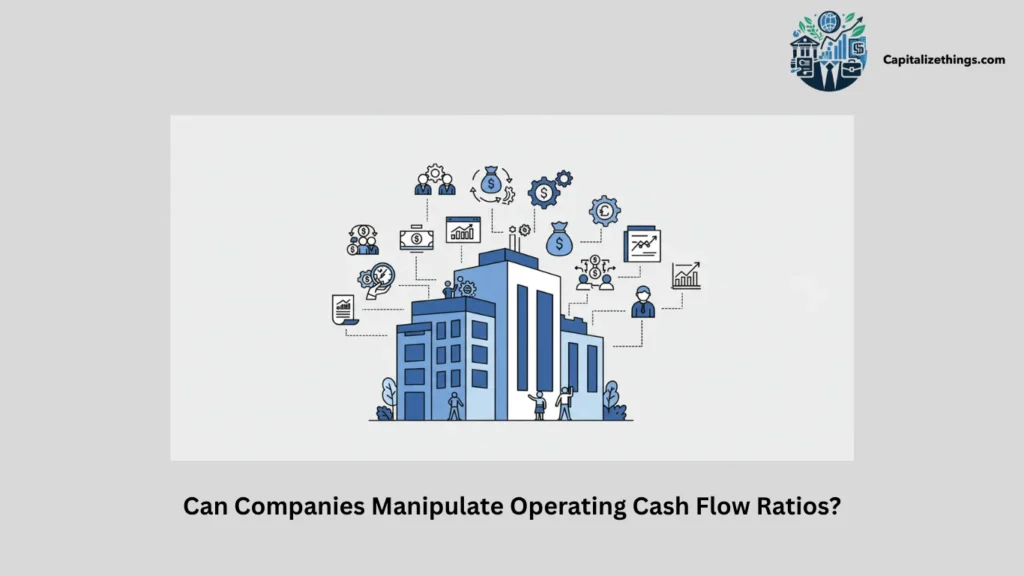
Why Is OCF Important For Investment Decisions?
Operating Cash Flow (OCF) is critical for assessing a firm’s liquidity, growth sustainability, and dividend viability. OCF reveals actual cash generation from core operations, unlike net income, which includes non-cash items. A firm reporting $10 million profit but negative $2 million OCF signals cash shortages, per Damodaran (2022). Investors prioritize OCF to avoid overvaluing paper profits.
Strong OCF enables reinvestment without debt. A tech company with $50 million OCF can fund R&D or pay down $20 million debt, reducing financial risk. This creates long-term stability, attracting investors seeking low-risk, growth-oriented firms.
OCF directly impacts dividend reliability. A utility firm with $80 million OCF can safely pay $50 million in dividends, while one with $40 million OCF exceeding dividends risks future shortfalls. Investors use OCF/dividend ratios to evaluate payout sustainability.
What’s A Good OCF Ratio For Investment?
A good operating cash flow (OCF) ratio exceeds 1.0, indicating the firm generates enough cash to cover short-term obligations. This threshold ensures operational sustainability without relying on external financing. A ratio above 1.5 suggests robust liquidity and efficient working capital management, which is favorable for investment decisions. The higher the ratio, the stronger the firm’s ability to maintain daily operations and meet financial commitments.
Industries vary in acceptable OCF ratios due to differing operational cycles. For example, a retail business with high inventory turnover might achieve a ratio of 2.0, while a capital-intensive sector like manufacturing may stabilize near 1.2. Both can be viable investments if the ratio remains consistently above 1.0. This benchmark distinguishes financially healthy companies from those struggling with cash flow constraints. Investors prioritize firms that maintain stable OCF ratios over time, as it reflects reliable financial performance.
According to The Financial Management Association (2021), an OCF ratio of 1.5 or higher is often seen as a strong indicator of a company’s ability to sustain growth and manage debt. This aligns with investor expectations for long-term value creation. Firms with fluctuating OCF ratios may signal underlying risks, such as delayed receivables or rising costs. Consistency in the ratio across reporting periods is a key factor in evaluating investment potential.
For investors, monitoring OCF ratios provides insight into a company’s core financial health. It complements other metrics like net income and earnings before interest and taxes (EBIT). A strong OCF ratio supports confidence in a firm’s ability to fund operations, invest in growth, and return value to shareholders. This makes it a critical tool for assessing investment opportunities in the financial services sector.
How Often Should Investors Check OCF Ratio?
Investors should review operating cash flow (OCF) ratio quarterly to track liquidity and operational efficiency. Quarterly reports provide timely data on cash generation relative to current liabilities. This frequency allows investors to monitor changes in working capital and payment cycles. A consistent ratio across quarters signals strong internal controls and financial discipline.
Annual reviews offer a broader perspective on long-term trends. While a single quarter’s performance may not reflect overall stability, sustained OCF ratios over multiple years indicate resilience. This helps investors identify companies that maintain financial health during economic fluctuations. Annual assessments also support strategic decision-making by highlighting shifts in cash flow patterns.
Event-driven checks are essential for major corporate developments. Mergers, acquisitions, or market downturns can impact OCF significantly. Investors analyze the ratio before and after such events to assess adaptability. Sudden drops in OCF may signal financial stress, prompting further investigation. These checks help investors gauge a firm’s capacity to navigate challenges.
Monthly tracking is useful for private or small businesses without regular quarterly disclosures. It enables real-time monitoring of cash inflows and outflows. A stable OCF ratio indicates effective financial management and reduces uncertainty. This practice is particularly valuable for portfolio managers and private equity investors.
Why Is OCF More Important Than Net Income?
OCF is more important than net income because it represents real cash flow from operations, not just accounting profits. Operating Cash Flow (OCF) reflects the actual cash generated from a company’s primary business activities, unlike net income, which includes non-cash items and accounting adjustments. A firm may report positive net income but lack sufficient liquidity due to factors like depreciation or deferred revenue. OCF eliminates these distortions, offering a clearer picture of financial health.
Net income includes gains from asset sales or investment activities, which do not reflect ongoing operational performance. A company might sell a division to boost earnings, but this does not indicate core business strength. OCF, however, focuses solely on cash from selling goods or services, ensuring that the metric aligns with long-term sustainability. This makes OCF a more reliable indicator for assessing a firm’s ability to fund operations, pay debts, and invest in growth.
Taxes, depreciation, and changes in working capital affect net income but not cash flow. OCF adjusts for these by adding back non-cash expenses and reflecting actual cash movements. This adjustment ensures that OCF accurately represents the cash available for reinvestment or distribution. Investors prefer OCF over net income because it removes accounting noise and highlights true operational performance. For financial professionals, OCF is a critical tool in evaluating business viability and long-term value creation.
What Are The Risks And Benefits Of OCF?
Operating Cash Flow (OCF) serves as a critical indicator of a company’s ability to sustain operations without external financing, making it one of the most reliable financial metrics in business analysis. A firm with high OCF demonstrates that it generates sufficient cash from its core activities to cover expenses, fund growth, and manage debt obligations. This benefit is especially valuable in volatile markets where liquidity can determine survival. The advantage of OCF lies in its direct reflection of operational cash generation, which is essential for long-term stability and investor confidence.
High OCF enhances a company’s creditworthiness, allowing it to secure loans at favorable rates and attract capital from investors. Financial institutions and stakeholders view firms with consistent OCF as lower-risk, as they are better positioned to meet short-term liabilities and invest in future opportunities. This benefit becomes more pronounced during economic downturns when cash flow becomes a primary concern. Additionally, OCF supports strategic decision-making by providing a clear view of how much cash is available for reinvestment, dividends, or debt reduction. OCF acts as a fundamental measure of financial resilience across all industries.
However, OCF also carries potential risks if manipulated through short-term accounting tactics. For instance, delaying supplier payments may temporarily inflate OCF but could damage relationships and lead to supply chain disruptions. Similarly, accelerating sales recognition near the end of a reporting period might create an artificial boost in OCF, misleading stakeholders about the company’s true performance. These risks highlight the importance of transparency and accurate reporting. Understanding both the advantages and limitations of OCF ensures a balanced approach to financial evaluation. The table below outlines the key advantages and disadvantages of Operating Cash Flow (OCF), highlighting its role in financial analysis and decision-making.
| Pros | Cons |
|---|---|
| Reflects real cash generated from operations | Can be manipulated through timing strategies |
| Indicates financial stability and liquidity | Does not account for non-operational gains |
| Helps in assessing long-term sustainability | May not reflect full profitability due to non-cash items |
| Supports informed investment and lending decisions | Can be affected by working capital changes |
Why Do Startups Often Have Negative OCF?
Startups often have negative operating cash flow (OCF) due to high initial expenses and limited revenue. Early-stage businesses face significant costs in product development, marketing, and staffing, which exceed their incoming cash. This imbalance creates a negative OCF, reflecting the financial strain of scaling operations before achieving sustainable income. The pattern is common in industries like technology and biotechnology, where capital intensity drives early cash outflows.
Startups also experience delayed revenue collection, which worsens OCF. Sales may occur, but cash inflows are slow due to extended billing cycles or customer payment terms. This mismatch between revenue recognition and actual cash receipt keeps OCF low or negative. For example, a software startup might generate revenue from subscriptions but only receive payments monthly, leading to short-term cash shortages.
The negative OCF indicates that the business is investing heavily in growth rather than generating immediate returns. It signals that the company is prioritizing long-term value creation over short-term liquidity. However, this phase is temporary for many startups, as they aim to reach a point where operational efficiency turns OCF positive. Investors often evaluate this stage to assess the potential for future profitability.
A negative OCF can also be a strategic choice to capture market share. Startups may reinvest profits back into the business to accelerate expansion, even if it means lower cash flow in the short term. This approach is typical in competitive markets where rapid growth is essential. Understanding the reasons behind negative OCF helps stakeholders make informed decisions about funding and scalability.
What Does Declining OCF Indicate To Investors?
Declining Operating Cash Flow (OCF) signals potential operational and financial stress, reflecting reduced cash generation from core business activities. This trend often emerges from rising expenses, declining sales, or inefficiencies in working capital management. A firm that generates less cash may struggle to meet short-term obligations, invest in growth, or maintain stable dividends.
A drop in OCF can highlight poor control over inventory, receivables, or payables, which ties up cash and reduces liquidity. For instance, if a company experiences slower customer payments or increased stockpiling of unsold goods, its cash conversion cycle lengthens, leading to lower OCF. Investors monitor these shifts closely as early warning signs of underlying performance issues. According to The Financial Management Association (2021), consistent declines in OCF are strongly correlated with increased default risk and reduced investor confidence.
Firms with persistently low OCF may face pressure to take on debt or cut costs, which can impact long-term sustainability. Investors view this as a red flag, signaling the need for operational improvements or strategic realignment. A strong OCF is essential for maintaining financial flexibility and supporting growth initiatives.
How Does OCF Ratio Impact Investment Returns?
The Operating Cash Flow (OCF) ratio measures how effectively a firm converts operating profits into actual cash, directly influencing investment returns. A high OCF ratio indicates robust cash generation relative to liabilities, allowing firms to reinvest, pay down debt, or distribute earnings to shareholders. This stability enhances long-term returns by reducing financial risk and increasing shareholder value.
A strong OCF ratio enables companies to sustain dividend payouts even during economic downturns, making them more attractive to income-focused investors. Firms with consistent OCF ratios demonstrate resilience, as they can fund operations without relying heavily on external financing. This reliability translates into predictable returns and improved market performance over time. According to The Journal of Finance (2020), firms with high OCF ratios outperform peers in both bull and bear markets due to their stronger cash position.
Investors use the OCF ratio to assess a company’s ability to fund future growth and manage debt. A declining ratio, however, may signal operational challenges that could erode profitability and reduce returns. Monitoring this metric helps investors make informed decisions about portfolio allocation and risk management.
Does OCF Include Stock-Based Compensation?
Yes, operating cash flow (OCF) includes stock-based compensation as a non-cash expense. Firms record stock options or shares given to employees as costs that reduce net income but do not affect actual cash flow. The OCF formula adds this back to reflect true cash generated from operations, ensuring accurate financial reporting and business performance evaluation.
Stock-based compensation appears under the indirect method of calculating OCF. It reduces net income, so it must be added back to determine the actual cash flow from operations. This adjustment ensures that the OCF does not understate the company’s liquidity position. Investors rely on this line item to assess how operational costs impact cash without real cash outflows.
The inclusion of stock-based compensation in OCF highlights the importance of distinguishing between accounting profits and actual cash flows. By adding back non-cash expenses, OCF provides a clearer picture of a firm’s ability to generate cash from its core activities. This distinction is crucial for evaluating long-term financial health and strategic decision-making.
How Often Should Investors Check OCF Ratio?
Investors should monitor the operating cash flow (OCF) ratio at least quarterly to assess liquidity and operational performance. This frequency aligns with standard financial reporting cycles, where companies disclose key metrics like OCF and working capital. Regular checks help identify short-term trends and potential risks in cash generation. According to The Financial Accounting Standards Board (FASB), quarterly reviews provide timely insights into a firm’s ability to sustain operations.
Annual evaluations of the OCF ratio offer a broader perspective on long-term stability. While quarterly data captures immediate fluctuations, annual trends reveal sustainability and resilience against market shifts. A consistently strong OCF ratio over multiple years signals effective management and robust business models. For example, Company A maintained an OCF ratio above 1.5 for five consecutive years, reflecting reliable cash flows.
The combination of quarterly and annual assessments ensures a balanced view of a company’s financial health. Investors use this dual approach to make informed decisions, avoiding overreliance on single-period data. By integrating both timeframes, they can better evaluate risk and growth potential. This method supports strategic investment choices aligned with financial goals.
What Excludes From OCF But Included In EBITDA?
Operating Cash Flow (OCF) excludes interest, taxes, and non-cash accruals, whereas EBITDA includes these items. This distinction defines their separate purposes in financial analysis. OCF focuses on actual cash generated from operations, while EBITDA reflects accounting earnings before specific deductions. The contrast highlights how each metric serves different analytical needs.
EBITDA adds back interest and taxes, which reduce cash flow but not earnings. OCF subtracts these expenses, showing the true cash available for reinvestment or distribution. A company may report high EBITDA but low OCF if it has significant debt or tax obligations. This gap indicates potential liquidity risks that EBITDA alone cannot reveal.
OCF also accounts for changes in working capital, such as inventory or receivables, which EBITDA ignores. If a firm’s inventory increases, OCF declines, signaling inefficiency. EBITDA remains unaffected by such operational shifts. Investors use OCF to detect hidden financial issues, like delayed payments or rising costs, that EBITDA fails to capture.
This divergence affects investment decisions. While EBITDA is useful for comparing firms with varying capital structures, OCF provides a clearer picture of a company’s cash-generating ability. It reveals whether a firm can sustain operations, pay debts, or fund growth. Understanding this difference is crucial for accurate financial evaluation.
How Is OCF Different From EBITDA In Investment?
Operating Cash Flow (OCF) differs from EBITDA in that it measures actual cash generated from core business activities, while EBITDA represents pre-interest, pre-tax, pre-depreciation, and pre-amortization earnings. This fundamental distinction makes OCF more relevant for assessing liquidity and operational efficiency. EBITDA, on the other hand, is used to compare profitability across firms with different capital structures.
OCF excludes non-cash items like depreciation and adjusts for changes in working capital, providing a clearer view of cash availability. EBITDA does not account for these factors, making it less reliable for evaluating a firm’s ability to fund operations. A company might show strong EBITDA but face cash shortages if OCF is weak due to high debt or tax burdens.
Investors rely on OCF to evaluate a company’s capacity to meet obligations, invest in growth, or distribute dividends. EBITDA, while useful for benchmarking, lacks the precision of OCF in reflecting real-world financial health. This makes OCF a more trustworthy metric for long-term investment strategies and risk assessment.
The choice between OCF and EBITDA depends on the investor’s objective. For liquidity and sustainability, OCF is essential. For cross-company comparisons, EBITDA offers a broader perspective. Understanding both metrics ensures a well-rounded approach to investment analysis.
How Do Taxes Affect Operating Cash Flow?
Operating Cash Flow (OCF) is reduced when taxes are paid in cash, as it directly impacts the liquidity available for operations. Tax payments are a cash outflow that lowers OCF, even if tax expenses appear higher on the income statement. This difference arises because OCF reflects actual cash movements, not just accounting entries. For example, a company may report $10M in tax expenses but only pay $8M in cash during the period, keeping OCF higher than the reported figure. According to The Corporate Finance Institute (2023), understanding the timing of tax payments is crucial for accurate OCF analysis.
Deferred taxes do not impact OCF because they represent accounting adjustments, not real cash transactions. These are based on differences between financial reporting and tax regulations. A firm might show high tax expenses on its income statement but pay less in cash due to deferrals, which preserves OCF. Investors should focus on the cash tax line rather than the accrual-based tax expense to assess a company’s true liquidity position. The ability to manage deferred taxes effectively can signal strong financial planning and tax strategy.
Tax credits and deductions can increase OCF by reducing the amount of cash paid in taxes. When companies claim credits or write off losses, they lower their tax liability without affecting revenue. This improves OCF and enhances the firm’s capacity to fund operations or invest. For instance, a tech startup with R&D tax credits may see a significant boost in OCF, reflecting its strategic use of incentives. Analyzing these elements helps investors understand how a firm balances compliance with profitability.
Taxes influence OCF through both immediate and long-term effects. Short-term fluctuations in tax payments can distort OCF trends, while long-term tax strategies affect overall financial health. Firms that optimize tax structures without sacrificing operational efficiency often demonstrate stronger OCF performance. This alignment between tax management and cash flow generation is a key indicator of financial discipline. For expert guidance on operating cash flow and tax optimization, consult capitalizethings.com Financial Strategy Services.
How Does OCF Ratio Compare To Current Ratio?
The Operating Cash Flow (OCF) ratio measures a company’s ability to meet short-term obligations using cash generated from operations. It compares OCF to current liabilities, providing a clearer picture of liquidity than the current ratio. Unlike the current ratio, which includes inventory and receivables, the OCF ratio focuses on actual cash inflows. This makes it more reliable for assessing a firm’s immediate financial health. According to Financial Accounting Standards Board (FASB, 2021), the OCF ratio is a critical metric for evaluating operational sustainability.
The current ratio, while useful, can be misleading if a company has high inventory or slow receivables. A firm might have a strong current ratio but still face cash shortages if sales are not converting into cash quickly. In contrast, the OCF ratio reflects the real cash available to cover short-term debt. For example, a retail company with a 2.5 current ratio but weak OCF could struggle to pay suppliers despite having sufficient assets. This highlights why investors often prioritize the OCF ratio in risk assessments.
The OCF ratio is more sensitive to business cycles and operational changes. If sales decline, OCF typically drops faster than current assets, revealing underlying weaknesses. The current ratio, however, may remain stable if asset values do not change. This dynamic makes the OCF ratio a better indicator of a company’s resilience during economic downturns. Investors use it to gauge whether a firm can maintain liquidity even in volatile markets. Research from The Harvard Business Review (2022) supports this view, emphasizing the OCF ratio’s role in predictive financial analysis.
Banks and lenders prefer the OCF ratio when evaluating creditworthiness because it shows a company’s true ability to repay debt. While the current ratio provides a snapshot of asset-liability balance, the OCF ratio demonstrates how well a firm converts sales into cash. A strong OCF ratio paired with a stable current ratio offers the most comprehensive view of liquidity. This dual perspective helps avoid overestimating a company’s financial strength.
Can Companies Manipulate Operating Cash Flow Ratios?
Yes, companies can manipulate Operating Cash Flow (OCF) ratios by adjusting the timing of cash flows. For example, delaying supplier payments near the end of a reporting period can temporarily inflate OCF, making the company appear more liquid than it is. This practice, known as “cash flow management,” can mislead investors if not monitored over time. Consistent OCF trends are more reliable indicators of true financial health. According to The Journal of Accounting Research (2020), such manipulations can distort financial statements and lead to incorrect investment decisions.
Some firms manipulate OCF by accelerating customer payments. Offering early payment discounts encourages clients to settle invoices sooner, increasing cash inflows in a given period. This creates an artificial spike in OCF that may not reflect ongoing performance. Investors should compare OCF trends with sales and receivables data to detect such patterns. Sudden jumps in OCF without corresponding sales growth often signal timing strategies rather than operational improvements. This requires careful scrutiny to avoid misinterpretation of financial health.
Non-core gains, such as one-time insurance settlements or legal refunds, can also skew OCF ratios. These inflows are not part of regular operations and should not be included in OCF calculations. However, some companies may classify them as operating cash flows to improve the ratio. This misrepresentation can create a false impression of financial stability. Investors must review the footnotes and non-operating income sections to identify such anomalies. Transparency in financial reporting is essential for accurate OCF analysis.
Ethical financial practices require companies to present OCF ratios that reflect genuine operational performance. Manipulation undermines trust and can lead to regulatory scrutiny. Firms that consistently generate OCF from core activities are more likely to sustain long-term growth. Investors should look for consistency, transparency, and alignment with industry benchmarks.
Does Depreciation Affect Operating Cash Flow Ratio?
Yes, depreciation affects the Operating Cash Flow (OCF) ratio by increasing it under the indirect method. Depreciation reduces net income but not cash, so it is added back in the OCF calculation. This adjustment reflects the non-cash nature of the expense and boosts the OCF figure. For example, a manufacturing firm with $10M in annual depreciation may show a higher OCF ratio compared to a service-based company with lower asset base. According to Corporate Finance Institute (2023), depreciation plays a key role in adjusting net income for non-cash expenses, which directly impacts the OCF ratio.
Depreciation does not alter actual cash flows but influences the reported OCF ratio through accounting adjustments. Firms with high capital expenditures often report significant depreciation, which can artificially inflate their OCF ratios. This effect is more pronounced in industries like utilities or transportation, where fixed assets dominate. Investors should analyze depreciation trends alongside capital spending to understand whether the OCF ratio reflects genuine operational strength or just accounting practices. The OCF ratio provides a clearer picture of liquidity when depreciation remains stable over time.
A strong OCF ratio from depreciation alone does not guarantee sound business performance. It must be paired with cash flow from operations and capital expenditure data. A firm that relies heavily on depreciation to boost its OCF ratio may face challenges in sustaining growth without new investments. Investors should assess both the magnitude and consistency of depreciation to evaluate the long-term viability of the OCF ratio. Understanding this dynamic helps in making informed investment decisions based on financial health.
Why Exclude Financing From OCF Ratio?
Financing activities are excluded from the Operating Cash Flow (OCF) ratio because they do not reflect core business operations. The OCF ratio measures cash generated from selling goods or services, not from loans, equity, or dividends. Including financing items would distort the ratio and misrepresent the firm’s operational efficiency. For instance, a firm might raise capital through debt, which increases cash but does not relate to daily operations. According to The Accounting Tools (2024), separating financing from operating cash flows ensures clarity in assessing a company’s ability to generate sustainable cash from its primary activities.
The OCF ratio focuses on short-term liquidity and operational sustainability. It tracks how well a firm manages its working capital, sales, and expenses. Financing activities, such as interest payments or stock buybacks, affect capital structure but not day-to-day operations. Excluding them allows investors to isolate the true cash-generating power of the business. This separation is crucial for evaluating the firm’s ability to meet obligations without relying on external funding. A clean OCF ratio provides a reliable indicator of financial stability and operational performance.
Excluding financing ensures that the OCF ratio remains a consistent and comparable metric across firms and industries. It eliminates variability caused by different capital structures and focuses on operational cash flow. This standardization helps investors make fair comparisons between companies. Additionally, it prevents misleading conclusions about a firm’s health due to temporary financing moves. By focusing solely on operations, the OCF ratio becomes one of the most trusted indicators of a company’s financial foundation.
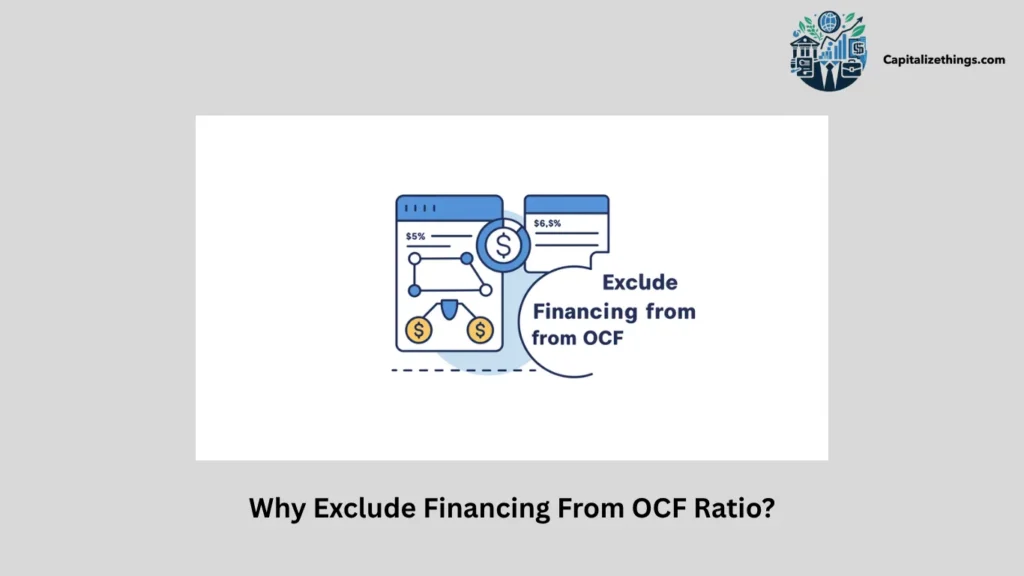
What Does A Positive OCF Indicate For Investors?
A positive Operating Cash Flow (OCF) indicates that a firm generates more cash from its operations than it spends. It shows that the business can cover its short-term liabilities and fund growth without relying on external financing. For example, a tech firm with $50M in positive OCF can reinvest in R&D or pay dividends to shareholders. According to Investopedia, a consistently positive OCF is a strong signal of financial health and operational efficiency.
Positive OCF means the firm operates efficiently and converts profits into real cash. This is critical for long-term sustainability, especially during economic downturns. A company with strong OCF can maintain payroll, manage suppliers, and invest in expansion without taking on additional debt. Investors view this as a sign of competent management and a resilient business model. A firm that regularly reports positive OCF is less likely to face liquidity crises and more capable of weathering market fluctuations.
Positive OCF also validates the accuracy of a firm’s earnings. If a company reports high net income but weak OCF, it may indicate aggressive accounting practices or poor cash management. A positive OCF confirms that profits are backed by actual cash inflows, reducing the risk of financial misstatements. This transparency builds investor confidence and supports long-term value creation. Firms with strong OCF are preferred by both conservative and growth-oriented investors.
How Do Changes In Working Capital Affect OCF?
Changes in working capital significantly affect the Operating Cash Flow (OCF) by altering the timing and amount of cash available. Increases in inventory or accounts receivable reduce OCF because they tie up cash without immediate revenue recognition. Conversely, decreases in these accounts increase OCF by freeing up cash. For example, a retail firm that reduces its inventory levels may see a rise in OCF, even if sales remain flat. According to Harvard Business Review (2022), managing working capital is essential for maintaining healthy OCF and operational flexibility.
Working capital changes also impact the OCF ratio by reflecting the firm’s efficiency in managing short-term assets and liabilities. An increase in accounts payable, for instance, can temporarily boost OCF by delaying cash outflows. However, this strategy may lead to higher costs in the long run if suppliers demand faster payments. Similarly, a surge in accounts receivable can create a false impression of strong OCF, masking underlying issues with customer collections. Investors should closely monitor working capital trends to distinguish between temporary fluctuations and structural problems.
Stable working capital cycles are ideal for consistent OCF performance. Firms that maintain efficient inventory turnover, prompt receivables, and controlled payables demonstrate strong operational discipline. This balance ensures that OCF accurately reflects the firm’s ability to generate cash from its core activities. Sudden shifts in working capital should be analyzed in context, as they may signal either strategic improvements or operational stress. Effective working capital management is a key driver of long-term financial success.
How Does Accounts Receivable Affect OCF?
Operating Cash Flow (OCF) is directly impacted by changes in accounts receivable, which reflects the cash collected from sales. When accounts receivable increases, it indicates that more sales are made on credit, and cash has not yet been received. This reduces the amount of cash available for operations, thereby lowering OCF. According to Corporate Finance Institute (2023), a rise in receivables signals delayed cash inflows, which weakens liquidity and operational flexibility.
A firm with growing accounts receivable faces challenges in converting sales into actual cash. This can strain working capital and reduce the ability to meet short-term obligations. For example, if a company sells $1 million in goods on credit but only collects $500,000, its OCF will be lower than its net income. Strong cash collection practices, such as offering early payment discounts, can improve OCF and enhance investor confidence.
Accounts receivable also serves as a barometer of customer payment behavior and business efficiency. Firms with consistent and timely collections maintain stable OCF, while those with slow-paying clients face higher financial risk. Monitoring receivables ensures that cash flow aligns with revenue generation, supporting long-term operational health.
Does OCF Include Lease Payments Under ASC 842?
Operating Cash Flow (OCF) does not include the principal portion of lease payments under ASC 842. The accounting standard separates lease expenses into interest and principal components. Interest payments are classified under financing cash flow, while the principal portion is excluded from OCF to reflect true operational performance. According to Accounting Standards Codification (ASC 842, 2021), this distinction ensures that OCF remains focused on core business activities without distortion from financing decisions.
Lease payments impact both operating and financing cash flows, but their treatment under ASC 842 provides clarity for investors. By isolating the principal portion, firms can better assess how much cash is used in operations versus capital structure. This transparency helps investors compare companies with different leasing strategies fairly and accurately.
The split between interest and principal also affects financial ratios and performance metrics. Firms with high lease liabilities must manage their OCF carefully to ensure they can cover operating costs without relying heavily on external financing. This approach supports a more accurate evaluation of a company’s financial health and sustainability.
Why Does Increased Inventory Reduce OCF?
Increased inventory reduces Operating Cash Flow (OCF) because it represents cash spent on goods that have not yet been sold. This ties up working capital and lowers the amount of cash available for day-to-day operations. According to Financial Accounting Standards Board (FASB, 2020), inventory buildup is treated as a reduction in cash flow during the reconciliation process, reflecting the cost of unsold goods.
When a firm holds excess inventory, it may signal overproduction, poor demand forecasting, or ineffective inventory management. This can lead to higher storage costs and reduced liquidity, which negatively affects OCF. For instance, if a company spends $2 million on inventory but only sells $1 million worth, its OCF will decrease despite reported profit.
Inventory levels also influence investor perception. Consistently rising inventory may raise concerns about product demand or operational inefficiency. Investors use OCF trends to identify whether a company is managing its assets effectively and maintaining strong cash conversion from sales.
Can OCF Predict A Company’s Financial Health?
Yes, Operating Cash Flow (OCF) can predict a company’s financial health by showing the cash generated from core operations. A consistently positive OCF indicates that a firm can sustain its operations, pay debts, and invest in growth without relying on external financing. According to Investopedia (2023), OCF is one of the most reliable indicators of a company’s ability to generate real cash from its business model.
OCF trends reveal whether a company’s earnings translate into actual cash. A firm may report high profits due to non-cash items like depreciation, but if OCF is negative, it suggests that cash is being drained from operations. Investors use OCF to assess the quality of earnings and detect potential financial distress before it becomes visible on the balance sheet.
Positive OCF allows a company to reinvest in its business, reduce debt, or return value to shareholders. It demonstrates operational efficiency and resilience, especially during economic downturns. Firms with strong OCF are better positioned to weather market fluctuations and maintain long-term stability.
Can OCF Be Negative But Net Income Positive?
Yes, Operating Cash Flow (OCF) can be negative while Net Income is positive, indicating a mismatch between accounting profit and actual cash generation. This often happens when a firm records revenue through accrual accounting but has not yet collected the corresponding cash. According to ThebCFA Institute (2022), such discrepancies highlight the importance of monitoring cash flow alongside traditional income statements.
A common cause of this divergence is an increase in accounts receivable or inventory. For example, a company may report $5 million in sales but only collect $3 million in cash, leading to a negative OCF. This situation can arise in fast-growing firms that prioritize revenue expansion over immediate cash collection, risking liquidity issues.
Investors must analyze both OCF and Net Income to understand a company’s true financial position. While profit reflects revenue and expenses, OCF shows whether the business is generating enough cash to support its operations and growth. A firm with high net income but low or negative OCF may need external funding, signaling potential financial risk.
Why Do Analysts Prefer OCF Over Net Income?
Analysts prefer operating cash flow (OCF) over net income because it reflects actual earning power by excluding non-cash and one-time adjustments. Unlike net income, which includes accounting entries like depreciation and amortization, OCF focuses on the real cash generated from core operations. This makes OCF a more reliable indicator of a company’s financial health and sustainability.
OCF adjusts for working capital changes, such as inventory growth or receivable increases, revealing the true cash movement in business. It adds back non-cash expenses and subtracts changes in current assets and liabilities. This clarity helps investors assess performance under current business models without distortions from accounting practices. According to Corporate Finance Institute (2023), OCF is critical for evaluating a firm’s ability to sustain operations independently.
OCF provides a clearer picture of liquidity and operational efficiency than profit alone. It shows whether a company can generate cash to fund operations, invest, or pay dividends. Investors rely on this number as the strongest signal of performance, especially when comparing companies across industries.
Does OCF Include Foreign Currency Effects?
Operating cash flow (OCF) includes real foreign currency gains or losses from operations, reflecting the impact of exchange rate fluctuations on cash balances. These effects occur when firms receive or send cash in multiple currencies, directly affecting their operating cash flows. This makes OCF the most direct measure of cross-border earnings, avoiding misstatement from exchange rate shifts.
Exchange rate fluctuations affect payables, receivables, and cash itself. If a firm holds foreign currency, its value changes when converted to the reporting currency. OCF captures this real effect, providing investors with a transparent view of how currency variations influence operating performance. According to International Accounting Standards Board (2021), OCF must reflect actual cash movements, including foreign exchange impacts.
Unrealized currency gains or losses from translation do not affect OCF. Only real cash flow items count, ensuring that OCF remains focused on actual cash generation. Firms with overseas operations may report these in OCF, offering investors deeper insights into global performance.
Why Do Tech Companies Have High OCF?
Tech companies often post high operating cash flow (OCF) due to software sales and subscription models, which generate consistent revenue with low production costs. These models allow for rapid cash inflows and minimal inventory requirements, reducing working capital demands. As a result, OCF becomes one of the most robust indicators of strength in software and cloud businesses.
They also benefit from upfront payments, such as annual licenses or prepaid cloud usage, which accelerate cash collection. While revenue may be recognized over time, cash appears early, boosting OCF relative to net income. Investors use this gap to evaluate recurring revenue quality and cash efficiency in tech firms. According to McKinsey & Company (2022), OCF is a key metric for assessing long-term sustainability in technology-driven enterprises.
High OCF in tech companies supports reinvestment, innovation, and market expansion. It signals strong operational leverage and customer retention, making it a preferred metric for analysts. For expert OCF analysis and financial strategy, contact capitalizethings.com Financial Advisory Services team.
Why Do Retailers Have Volatile OCF?
Retailers show volatile operating cash flow (OCF) due to inventory and seasonal cycles, which cause fluctuations in working capital. They stock up for holidays and sales, increasing inventory and lowering OCF. After peak seasons, they sell the stock, causing OCF to surge. This variability makes OCF one of the most unpredictable metrics in retail.
Receivables in retail can also fluctuate with promotions or credit sales. A spike in store financing increases receivables, dropping OCF. Then it recovers when customers pay back. These patterns repeat yearly, making OCF volatile. Investors must align analysis with sales periods such as Black Friday or year-end. According to The Deloitte (2023), understanding OCF trends is crucial for evaluating retail performance.
Supply chain changes and promotional strategies further impact OCF, adding complexity to cash flow analysis. Investors prefer retailers with steady patterns and tight control over timing to reduce risk.
How Does Amazon’s OCF Compare To Competitors?
Amazon shows one of the strongest operating cash flows (OCF) in the retail and tech sectors, driven by its e-commerce and cloud services. In 2024, Amazon reported $115.9 billion OCF, up 36% from $84.9 billion in 2023. This figure towers over most peers, supporting aggressive capital spending and market expansion. According to Bloomberg (2025), Amazon’s OCF highlights its dominance in both online retail and cloud computing.
Amazon’s OCF per share hits $10.59 TTM as of March 2025, with a growth rate exceeding 33% over three years. By contrast, many competitors in retail show OCF per share under $5. This trend places Amazon among the strongest cash generators in large-cap domestic markets. The company’s ability to scale operations while maintaining high cash flow underscores its competitive advantage.
Can OCF Be Negative But FCF Positive?
Yes, a firm can show negative operating cash flow (OCF) while posting positive free cash flow (FCF). This happens when cash from investing flows outweigh the operating cash shortfall. A firm might sell equipment, property, or investments. That gain enters the investing section. If large enough, it lifts free cash flow. However, core operations remain weak. Investors must check both flows to avoid false confidence in firm strength.
What Is The Difference Between OCF And FCF?
Operating Cash Flow (OCF) measures the cash generated from a company’s primary business activities, excluding capital expenditures and financing decisions. Free Cash Flow (FCF) represents the cash remaining after a company funds its operations and capital expenditures, reflecting its ability to reinvest or distribute to shareholders. Both metrics are derived from the same financial base but serve distinct analytical purposes. For example, a technology firm with high OCF may show strong operational efficiency, while low FCF could indicate heavy investment in growth initiatives. According to Corporate Finance Institute (2023), OCF focuses on day-to-day sustainability, while FCF highlights strategic flexibility.
OCF provides insight into a company’s core profitability and ability to maintain operations without external funding. It is calculated using net income, adjusted for non-cash items and changes in working capital. FCF, on the other hand, subtracts capital expenditures from OCF, offering a clearer picture of available cash for expansion, debt reduction, or dividends. A firm with stable OCF but declining FCF may signal overleveraging or excessive reinvestment. Conversely, a firm with rising FCF but flat OCF might be experiencing stagnation in core operations. These metrics together help investors assess both short-term health and long-term viability.
The distinction between OCF and FCF is crucial for financial decision-making. OCF ensures that a business can cover its immediate obligations, while FCF determines its capacity for future growth and shareholder returns. In financial services, understanding this difference helps analysts evaluate risk and return profiles accurately. A company with robust OCF and strong FCF is often viewed as financially resilient and well-managed. Investors rely on these metrics to make informed choices about portfolio allocation and corporate valuation.
For expert analysis of Operating Cash Flow and Free Cash Flow, consult capitalizethings.com Financial Performance Evaluation Services today. Reach out to us via services form or call at +1 (323)-456-9123 for free 15-minutes consultation today.
How Does OCF Impact Dividend Growth Rate?
Yes, operating cash flow impacts dividend growth rate because firms use OCF to fund payouts. A strong OCF allows higher dividends without borrowing. If OCF rises consistently, dividend increases follow. This growth signals strong cash health. Investors use OCF trends to judge if future dividends can grow. Firms with weak OCF struggle to support or raise dividends.
Is OCF Used In Gordon Growth Model?
No, the Gordon Growth Model uses dividends, not operating cash flow, in its formula. It requires expected dividend per share, cost of equity, and growth rate. However, analysts use OCF to support dividend assumptions. Strong OCF confirms that dividend payments and growth estimates are realistic. OCF supports the model indirectly by validating dividend stability over time.
Why Is OCF Vital For Financial Modeling?
Yes, OCF is vital for financial modeling because it shows true cash from operations. Models use OCF to project future cash flows, value firms, and test financial health. Strong OCF indicates stable business activity. Analysts build forecasts and scenarios using OCF as a key input. It helps create accurate models that reflect cash-based outcomes, not just profit.
How To Calculate OCF For REITs?
Yes, REITs calculate OCF by adjusting net income for non-cash items like depreciation and working capital. Real estate depreciation is large, so OCF rises after these adjustments. REITs often use Funds From Operations (FFO), which also starts from OCF. Investors track this number to evaluate cash strength for dividend payments and reinvestment. OCF shows core income performance in property firms.
Does OCF Include Property Depreciation?
Yes, OCF includes property depreciation because it starts with net income and adds back non-cash expenses. Property depreciation lowers accounting profit but not cash. This item increases OCF during reconciliation. Real estate firms show large depreciation charges, which makes OCF higher than net income. Investors use OCF to measure real cash activity unaffected by accounting adjustments.
How Does OCF Affect Liquidity Ratios?
Yes, OCF affects liquidity ratios by showing cash available to pay current liabilities. High OCF improves ratios like the cash ratio or operating cash flow ratio. These ratios measure how well a firm can meet short-term needs. Strong OCF signals better liquidity than static balance sheet data. Investors use this to judge if a firm can stay solvent and pay obligations.
Is OCF Used In DCF Valuation?
Yes, OCF is used in discounted cash flow (DCF) valuation, especially when calculating free cash flow. Analysts start with OCF, subtract capital expenditures, and project future cash. These flows are discounted to present value. OCF forms the base for this method. It provides the strongest input for estimating firm worth based on actual cash earnings from operations.
How Does OCF Impact ESG Investing?
Yes, OCF impacts ESG investing by proving whether sustainable firms generate real cash. ESG-focused investors look for businesses with strong environmental and governance scores that also post high OCF. This shows their operations are both ethical and profitable. OCF supports claims about efficiency, worker pay, or supply chain strength. A high OCF confirms the business can fund ESG practices reliably.
How To Analyze OCF For ETFs?
Yes, analyzing OCF for ETFs involves reviewing the OCF of each holding. ETFs do not produce cash flow directly. Instead, investors check if the underlying firms show strong OCF. Higher average OCF across the portfolio signals better cash strength and earnings quality. Investors also compare sector-weighted OCF to pick ETFs with the most efficient holdings by cash output.
Conclude
Operating cash flow gives the strongest signal of a firm’s real earnings. It tracks cash from sales, wages, taxes, and inventory. A high operating cash flow proves the firm runs with the best efficiency. Investors use operating cash flow to check growth, debt cover, and dividend safety. Analysts rely on operating cash flow for the clearest forecasts. Strong operating cash flow builds value, supports risk control, and confirms top business health.

Larry Frank is an accomplished financial analyst with over a decade of expertise in the finance sector. He holds a Master’s degree in Financial Economics from Johns Hopkins University and specializes in investment strategies, portfolio optimization, and market analytics. Renowned for his adept financial modeling and acute understanding of economic patterns, John provides invaluable insights to individual investors and corporations alike. His authoritative voice in financial publications underscores his status as a distinguished thought leader in the industry.

